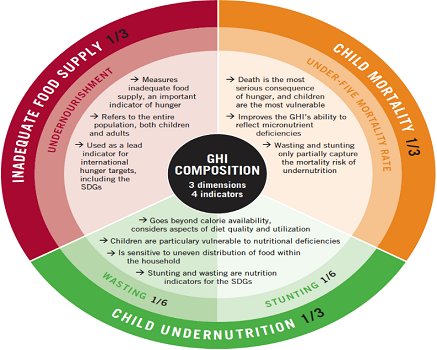GLOBAL HUNGER INDEX-2019
17, Oct 2019

Prelims level : Indices & Reports
Mains level : GS-II- Issues relating to Poverty and Hunger.
Why in News?
- In the recently released Global Hunger Index (GHI) Report-2019, India was ranked at 102nd position out of 117 countries.
About Global Hunger Index:
- The report is an annual peer-reviewed publication that is jointly prepared by the Concern Worldwide (an Irish agency) and the Welt Hunger Hilfe (a German organization).
- The GHI scores are based on a formula that captures three dimensions of hunger—insufficient caloric intake, child undernutrition, and child mortality—using four component indicators:
1.UNDERNOURISHMENT: the share of the population that is under-nourished, reflecting insufficient caloric intake
2.CHILD WASTING: the share of children under the age of five who are wasted (low weight-for-height), reflecting acute undernutrition.
3.CHILD STUNTING: the share of children under the age of five who are stunted (low height-for-age), reflecting chronic undernutrition.
4.CHILD MORTALITY: the mortality rate of children under the age of five.
Categorisation of countries:
- Based on the overall score of the country, the country has been classified as follows:
| Overall Score of the country | Category |
|---|---|
| <= 9.9 | LOW |
| 10.019.9 | MODERATE |
| 20.034.9 | SERIOUS |
| 35.049.9 | ALARMING |
| >=50.0 | EXTREMELY ALARMING |
- Each of the four component indicators is given a standardized score on a 100-point scale based on the highest observed level for the indicator on a global scale in recent decades.
- India’s overall score this year is 30.3 and has been categorised under “serious” category.
Key Findings of the Report:

- Seventeen countries, including Belarus, Ukraine, Turkey, Cuba and Kuwait, shared the top rank with GHI scores of less than five.
- The Central African Republic holds the bottom position in the index. The Central African Republic is in the “extremely alarming” level in the hunger index.
- Among the 117 countries, 43 have “serious” levels of hunger.
- Multiple countries have higher hunger levels now than in 2010, and approximately 45 countries are set to fail to achieve low levels of hunger by 2030.
- While there has been progress in reducing hunger, but the gains are now being threatened and severe hunger persists in many regions across the world. It is becoming difficult to feed the world due to climate change.
- The various steps recommended by the report to tackle this serious problem were:
- Prioritizing resilience among the most vulnerable groups, better response to disasters, addressing inequalities, action to mitigate climate change are among measures suggested in the report.
An overview of India’s Position and a comparison with its Neighbours:
- In the Global Hunger Index (GHI) Report-2019, India was ranked at 102nd position out of 117 countries.
- India’s rank has slipped from 95th position (in 2010) to 102nd (in 2019) behind its neighbours Nepal (73), Pakistan (94) and Bangladesh (88). China (25) has moved to a ‘low’ severity category and Sri Lanka is in the ‘moderate’ severity category.
- Over a longer-term duration, the fall in India’s rank is sharper, i.e, from 83rd out of 113 countries in 2000 to 102nd out of 117 in 2019.
- Countries like Yemen and Djibouti, which are conflict-ridden and facing severe climate issues respectively, fared better than India on that front, according to the report.
- Just 9.6% of all children between 6 and 23 months of age are fed a “minimum acceptable diet”, it said. “India’s child wasting rate is extremely high at 20.8%, the highest for any country in this report.
- The share of wasting among children in India marked a steep rise from 16.5% in the 2008-2012 to 20.8% in 2014-2018.According to UNICEF, child wasting is a strong predictor of mortality among children (under 5 yrs. of age).
- India has demonstrated an improvement in other indicators that includes, under-5 mortality rate, prevalence of stunting among children, and prevalence of undernourishment owing to inadequate food.
- The report also took note of open defecation in India as an impacting factor for health. It pointed out that as of 2015–2016, 90% of Indian households used an improved drinking water source while 39% of households had no sanitation facilities.
- Open defecation jeopardizes the population’s health and severely impacts children’s growth and their ability to absorb nutrients.






